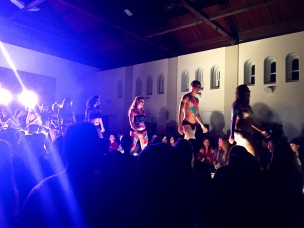
On Thursday night, a collection of bold individuals strutted, stripped, and danced down a brightly lit runway constructed inside Beckham for the Students of Color Fashion Show. The show, which was called “One Night in Beckham: An All Black Affair,” was organized by Matthew Padilla ’16 as a part of the Student of Color Program, seeking to exhibit diversity within the Wesleyan community to admitted students.
Here, the designers brought their all. In a piece called “Derelicte,” designed by Jesse Brooks ’16 and Lydie Blundon ’16, students adorned themselves with trash bags and various trash items and walked in pairs down the aisle toward a priest, all while dancing to disco songs. “We the People MMXXIII” presented a much more serious set, showcasing a Brooklyn-based brand inspired by street-wear culture.
While all of the pieces displayed the genius of their designers, the personality and enthusiasm of the models was also essential to the performance. In many of the sets, the models’ runway walks weren’t traditional: some swaggered slowly; some walked calmly to the middle and then broke into a dance halfway down; some went in pairs, stopping at various points to dance together. Seeing the clothing on models with such energy made it all the more desirable, in addition to rendering the show a holistically fun experience.
One standout set was “Exotik,” designed by Padilla and Wesley Close ’15. The performance was inspired by exotic dancing and focused on accepting it as a valid form of expression. Students performed in pairs, sometimes beginning clothed and stripping as they danced, or emerging in themed underwear sets. Drew Trotman ’18, who wore tuxedo-themed underwear for his performance, recounts that some of the groups carefully planned and choreographed their pieces, while others (including his) were almost entirely improvisation.
Clothing, or lack thereof, was not the main focus of all the performances. In a piece called “adorn(ment),” designed by Taylor Dauphin ’15, Gari François ’16, and Armani White ’15, three people painted the body of a fourth individual, while already-painted models walked in simple underwear. The designs on their bodies, painted in jewel tones with gold and silver, portrayed what they describe in the show’s program as the “natural beauty of the body’s canvas.”
Many of the sets contained messages about empowerment. “S.O.L. Walk,” a set designed by Nzingha Rawlins ’16, was produced entirely by black women, from the designer to the models to the musicians. The tailored but athletic clothing was almost all black and white, and highlights included a cropped black top with a white drawstring at the hem, a black-and-white printed kimono, and a checkerboard romper.
A set called “Box Positivity,” which was designed by Alicia White ’15, sought to a body-positive form of empowerment.
“The concept focuses on body positivity, healthy attitudes towards sex, and people coming together to support each other’s identity,” White’s description in the program read.
Models walked in brightly colored, sparkled, or bejeweled items, some of them adorned with a logo of a box with a plus sign next to it. Many of the outfits included royal aspects, such as a blazer with a jeweled crown on the back, or a sparkling cape. This set is connected to a Tumblr of the same name, which posts various empowering images and stories, all connected to feminism.
This empowerment theme was accompanied by a theme of acceptance, as demonstrated in “Intimate.” This performance showcased clothing as a way of encouraging viewers to accept and explore their own intimacy. These pieces ranged from simple underwear worn under white button-down shirts (which were eventually shed) to an BDSM-themed studded contraption, portraying and thereby embracing all types of intimacy.
During the intermission, eight prefrosh were invited to voluntarily walk down the runway in the clothes they were currently wearing. In an incredible display of confidence, each future Wesleyan student strutted to Beyoncé’s “Flawless.” One particularly popular walk was by a boy with a yo-yo.
“Everyone at this school is so hot,” Tricia Merlino ’18 raved after the show. “I think my prefrosh was scared by the partial nudity, though.”
She also noted during the first set, “BLAXCELLENCE,” designed by Etenish Abebe ’17, that she would wear all the outfits being showcased.
The final set, “DebonHair,” consisted of a series of elaborate and impressive hairstyles designed by Idara Foster ’15, Ngina Shillingford ’15, and Ama Essuman ’15.
While Merlino was right about the lack of censorship being slightly frightening to outsiders, this demonstrates perfectly how Wesleyan acts as a space for everyone to explore their passions and express them in creative ways. The show was also a celebration of Wesleyan itself, acting as a perfect demonstration for prefrosh of not only how we embrace every viewpoint that students bring to the table, but also how we have fun doing so.


Leave a Reply